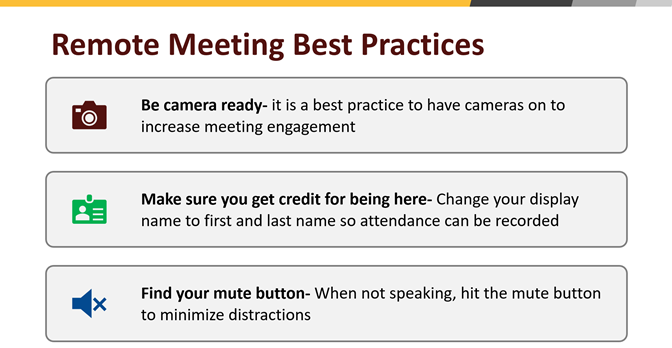By: Brandon Sanchez
The COVID-19 pandemic dramatically altered the way that most business models operated. Despite being well versed in remote work best practices, the Yellow Brick team still had to adapt the way we supported our clients. Understanding that our usual in-person approach to planning and project management would not be possible due to social-distancing measures and increased safety precautions, we focused on leveraging technology to improve the dynamic between our clients and our team. As we settle into 2021, the Yellow Brick team continues to adjust to a work environment dominated by remote meetings and virtual interactions. With some big wins and some tough lessons learned behind us, we asked our team members to share their insights from navigating the world of Transition and Activation planning virtually.
Hybrid vs. Fully Virtual Meetings
With the desire to limit the number of individuals gathered in the same space, hybrid meetings have become a new trend. Although the occasional conference line participant was typical before COVID-19, today’s hybrid meetings present a very different dynamic. As a facilitator of a hybrid meeting, you balance in-person participants with phone or video conference participants, or both simultaneously, which can be an arduous task. While the intention is to include additional perspectives, our team has found that these hybrid meetings can fragment the discussions, as both sets of attendees often speak over each inadvertently. Technology and connection challenges remain common, leaving either the in-person or virtual attendees unable to understand clearly and provide input.
Lesson Learned: Having managed both types of meetings, Yellow Brick favors entirely virtual meetings rather than hybrid meetings. To make the best use of participants’ time, our team recommends only including participants who need to be in the forum to make decisions. When Project Manager Christina Olivarria was amid restructuring client workflow meetings due to COVID-19, she worked with her client partner to determine which participants were required. She also restructured the meeting agenda to allow participants to attend focused sessions rather than the entire workflow exercise, which participants appreciated.
Build a Remote Meeting Culture
Even with the most reliable tools and well-thought-out virtual strategies, a project’s success level in the current “remote meeting” environment can be encouraged or impaired by an organization’s culture.
Project Manager Ali Broders shared that organizations that swiftly adopt new technologies and set expectations for virtual meeting norms at the start of the project have experienced great success hosting virtual meetings. When asked what she believes contributes to individual project success, Ali shared that leadership engagement is critical. “Leaders set the expectation that attendees will be present and engaged in virtual meetings with their computer cameras turned on. Staff saw this behavior from leadership and followed suit.”
Being able to see meeting participants is essential to facilitating productive meetings. Seeing faces helps us learn participants’ names, connect personally, and gauge if people are listening and understanding the material being presented. One of Ali’s strategies has been to preemptively notify meeting attendees when a meeting requires them to view their computer screens. “We let them know that we’re going to be screen-sharing and reviewing floor maps, so you need to be at a computer; please do not only call in!”
For new teams with unforged relationships, Yellow Brick recommends introducing these virtual meeting tactics at the start of a new project:

Lesson Learned: Although these simple strategies help integrate a human element into virtual meetings, there is no substitute for reading the room. Virtual meetings hinder the ability to evaluate body language. When screen-sharing, meeting facilitators are often unable to view the gallery of remote meeting participants. Meeting facilitators thus have to rely on their team to watch for any comments in the chatbox, gauge the audience’s facial expressions, and ensure everyone has the opportunity to speak.
Remote Project Kick-off
Commencing a new operational or Transition and Activation Planning project is a large endeavor; doing so in virtual interactions increases complexity. The time required to learn the organization’s culture and the project leads, department stakeholders, and committee members can make the first few months of a new project challenging. “So much of our reputation is built on our relationships and the partnerships we form with our clients. It is much easier to migrate to virtual meetings when you already know the client and have worked with the team. To kick off a new project remotely and never be in the same room as that person, shake hands, or look into their eyes, it’s so different,” explains Ali.
Project Manager Nick Tran stresses the importance of earning the trust between consultant and client. “We are here to make sure our clients are successful, and we make sure that our clients feel that we are part of their team.” When suddenly faced with developing a move plan at the height of the first wave of the COVID-19 pandemic, Nick learned first-hand how those strong relationships and earned trust come into play during periods of intensity.
“One of the most important things in a successful project is relationship building,” says Project Specialist Ann Ahmadi. “Just as we would onsite if you are (virtually) there a few minutes before the meeting starts, you can talk and connect with the two or three people who are also on the call early. Now more than ever, anything that you can do to connect is important.”
Virtual Workflow Planning
“As much as possible, set-up workflow materials in a way that allows the meetings to be a time for validation rather than creating,” shares Christina. Planning ahead of time increases the likelihood that meetings will be valuable to the participants. To accomplish this, our team works closely with the client to develop vetted workflow materials that participants can then validate.
This level of material preparation will “give your participants something to react to and act as a starting point,” adds Project Manager Ali Broders. “When you are in the same room and can have participants go up to the floorplans and draw a path of travel route, they can touch and feel the map to understand where they are coming from and going to, which helps them learn their new building.” Understanding that a virtual meeting environment does not allow people to physically point to and draw on materials, providing a draft to start enables participants to poke holes in a plan, which is extremely valuable.
Lesson Learned: Allow yourself a longer lead time to prepare for virtual sessions. Introduce the structure and expected outcomes of the workflow session in advance. These will maximize the efficiency of your virtual session and will help the group achieve the meeting goals. For workflow topics that involve staff outside of an existing meeting structure, Christina recommends recording an overview and sending it out ahead of time, emphasizing that “this allows us to jump into the workflow topic rather than spending time introducing what the workflow meeting will look like.”
Tips for Facilitating Large Virtual Events
In 2020, Yellow Brick utilized Zoom’s breakout room feature to create subgroups for over 100 attendees who collaborated on Dress Rehearsal scenario development. This Round Robin event is a session where Host and Contributing Departments review Dress Rehearsal scenarios to validate the Contributing Departments’ activities, assumptions for participation, and required equipment, supplies, technology, and people. Round Robin typically occurs a few months before the first interdisciplinary Dress Rehearsal event, in which representatives from each department impacted by the new healthcare project participate. Typically, Yellow Brick project managers and specialists act as facilitators for each department, enacting scenarios to maximize the learning and discovery during each Dress Rehearsal scenario.
The event was a success, as well as a lesson in logistics planning for large virtual events. Larger meetings require more resources to ensure the session runs smoothly and participants remain focused on the outcomes. The Yellow Brick team coordinated training sessions and conducted multiple test sessions to ensure the event ran smoothly.
Lesson Learned: There is no such thing as too much communication. Consider various methods of providing information to attendees. Additionally, do not assume that all participants are adept in virtual meeting platforms and features. In the future, Yellow Brick may plan to split larger virtual events into smaller groups to allow for focused support for each set of attendees.
Remote Support for Dress Rehearsal
One of the most exciting project milestones for our clients and our Yellow Brick team is our Dress Rehearsal events. These events are interdisciplinary testing exercises to simulate operations in the new healthcare environment before Day 1 Activation. Dress Rehearsal validates the effectiveness of the training Champions received. It also tests the new facility’s equipment, systems, technology, integration, and workflow processes before the first patient ever enters the door. Years of meticulous planning culminate with these events, and the experience of seeing it come together is a thrilling and challenging period of discovery and issue resolution.
In 2020, our client partners were faced with the challenge to open their new healthcare facilities amidst the need to care for a community deeply impacted by an ongoing pandemic. Due to quarantine restrictions, our Yellow Brick team had to envision the inevitable: facilitating a Dress Rehearsal event from afar. While the event’s goals and outcomes were unchanged, the facility’s leadership with Yellow Brick had to nix the typical large, in-person gatherings to kick-off the day, enjoy lunch, and end-of-day in favor of socially distanced department-level groups.
Since March 2020, our Yellow Brick Facilitators have joined their scenario groups virtually and not without challenges. “In the first remotely supported Dress Rehearsal, we were on a tablet held in somebody’s hand, and it was difficult not to get motion sickness! Using the rolling devices helped,” explains Kelly Guzman, Yellow Brick CEO/Project Executive. Another recurring theme with remotely planned and facilitated events is the additional preparation and training required to ensure success. Dress Rehearsal includes having an in-person member within each department who understands the Yellow Brick Facilitator’s role well enough to take charge if technology fails. Kelly shares a positive finding to this remote support, explaining how “we’ve achieved more buy-in from their internal facilitators now versus when they knew we would be there in person!”
Before adjourning at the end of the event, Senior Project Manager Kathy Stevenson shares that “a debrief at the end of the day, asking a group what their biggest realization is or what the best part of the day was, allows everyone a chance to contribute. It also helps us get to know them better, which is especially helpful if you’ll be remotely facilitating a 2nd or 3rd Dress Rehearsal with the same group.”
Lesson Learned: Yellow Brick’s first experience using “cyborg” facilitators came with two lessons. Much like a hybrid meeting, it is easy to forget about the virtual attendee, especially when “rolled” throughout a new facility. We suggest that an in-person member takes responsibility for maintaining contact with the remote Facilitator and ensures the rolling device stays with the group. Second, in the event of technology issues like connection drops, ensure that the Facilitator has trained the in-person Scenario Coordinator to be familiar with the Facilitator’s role. While Yellow Brick does not consider the remote facilitation of Dress Rehearsal ideal, we have achieved great success with careful coordination and training.
A full year into adapting the way we work and communicate, it is clear to our team that even the latest technology available will not be your complete answer to a successful remote-work project. “It certainly helps facilitate a connection with other people,” explains Ann. “What it will not do is replace the need for the human element in project management.”
Regardless of the technology we leverage to work remotely, it is the human element that builds trust, partnership, and motivation toward the common goal.
For a list of best practices to successfully execute remote work meetings, please find our blog post here.

